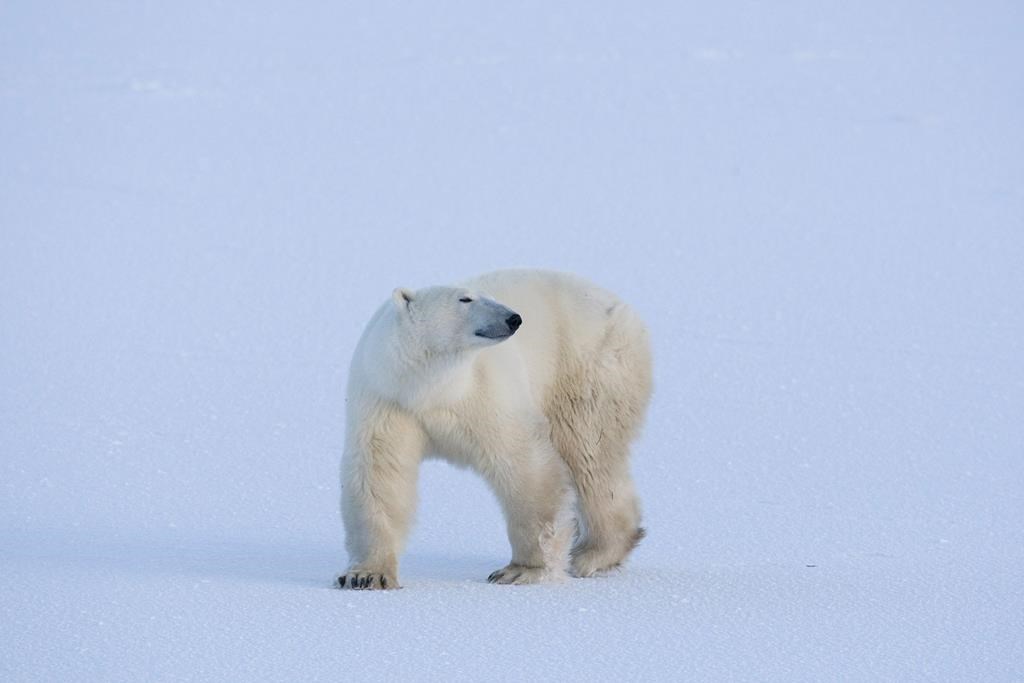Searching for polar bears where the Churchill River dumps into Canada’s massive Hudson Bay, biologist Geoff York scans a region that’s on a low fat, low ice diet because of climate change.

And it’s getting lower on polar bears.
There are now about 600 polar bears in the Western Hudson Bay, one of the most threatened of the 20 populations of the white beasts. That’s about half the number of 40 years ago, says York, director of research at Polar Bear International. His latest study, with a team of scientists from various fields, shows that if the world doesn’t cut back more on emissions of heat-trapping gases “we could lose this population entirely by the end of the century,” he says.
More than polar bears are threatened in this changing gateway to the Arctic, where warmer waters melt sea ice earlier in the year and the open ocean lingers longer. For what grows, lives and especially eats in this region, it’s like a house’s foundation shifting. “The whole marine ecosystem is tied to the seasonality of that sea ice cover,” University of Manitoba sea ice scientist Julienne Stroeve said.
When the sea ice melts earlier it warms the overall water temperature and it changes algae that blooms, which changes the plankton that feed on the algae, which changes the fish, all the way up the food web to beluga whales, seals and polar bears, scientists say.

“What we’re seeing is a transformation of an Arctic ecosystem into more of a southern open ocean,” York says in August from the bobbing up-and-down edge of a 12-foot Zodiac boat. “We’re seeing a transformation from high-fat plankton that leads to things like beluga whales and polar bears to low-fat plankton that end up with the final part of the food chain being jellyfish.”
Here, fat is good.
“To live in the Arctic you need to be fat, or live fat, or both,” said Kristin Laidre, a University of Washington marine mammal scientist who specializes in Arctic species.
The polar bear — the symbol of both climate change and an area warming four times faster than the rest of the world — is the king of fat. When mother polar bears nurse their young — as an Associated Press team witnessed on rocks outside of Churchill, Manitoba, the self-proclaimed polar bear capital of the world — what comes out in the milk is 30% fat, York says.

Get breaking National news
“If you think of the heaviest of heavy whipping cream, it would be just like drinking that,” York says. “This why you can have cubs that are born the size of my fist in January emerge in March at 20 to 25 pounds.”
Fewer of these cubs are being born or survive the first year because their mothers aren’t fat enough or strong enough to even get pregnant, York says.
Polar bears feed like crazy in the ice-covered spring. They use the sea ice platforms as bases to hunt their favorite prey, high-fat seals, especially baby seals.
In the Hudson Bay, unlike other areas where polar bears live, sea ice naturally disappears in the summer. So the polar bears lose their food supply. This has always happened, but now it’s happening earlier in the year and the ice free area is lasting longer, say York and Stroeve.
So most polar bears go hungry. Recent studies have shown that even hunting on land — caribou, birds, human trash — takes so much energy that bears that do it don’t really gain any more calories than those that just sit and starve.

“Here on Hudson’s Bay, we know from the long-term research that the bears today are spending up to a month longer on shore than their parents or grandparents did. That’s 30 days longer without access to food, and that’s on average,” York says.
Some years the bears get near the starvation threshold of 180 days. Polar bears can fast for less than that and do well, mostly because they are so good at gathering and storing fat for these lean periods, York says. During that lean time period, researchers monitoring bears found that 19 out of 20 of them lost 47 pounds in just three weeks, about 7% of their body weight.
Sea ice in the Arctic has shrunk by about 13% per decade — falling in large steps and plateaus — since 1979, according to the National Snow and Ice Data Center. While Arctic sea ice hit its fourth lowest extent on record for late August, in Western Hudson Bay unusual winds have meant longer lasting ice than usual, but it’s a temporary and very localized respite.
A peer-reviewed study this year from Stroeve and York looked at sea ice levels, that 180-day hunger threshold and climate simulations based on different levels of carbon pollution. The researchers found that once Earth warms another 1.3 or 1.4 degrees Celsius (2.3 to 2.5 degrees Fahrenheit) from now, the polar bears likely will cross that point of no return. Bears will be too hungry and this population likely dies out.
Studies, including those by the United Nations, that look at current efforts to curb carbon dioxide emissions project warming of about 1.5 degrees to 1.7 degrees Celsius (2.7 to 3.1 degrees Fahrenheit) from now by the end of the century.
“The populations will definitely not make it,” Stroeve said.
There’s about 4,500 polar bears in the three Hudson Bay populations and 55,000 beluga whales. Together, that’s more than 141 million pounds of fat large mammals. That seems huge, but those white beasts are losing a battle to an even larger weight: the amount of heat-trapping carbon dioxide the world spews into the air. It’s 154 million pounds every minute.

It’s not just polar bears.
University of Washington’s Laidre said some scientists think the smallest water zooplankton called copepods are the most important animals in the Arctic. They’re fat heavy and the staple of bowhead whales.
But copepods live on the smaller plant plankton that’s changing. The timing of when copepods can prosper is changing and new species are moving in, “and they are not as lipid rich,” Laidre said.
“It’s not that nothing lives out there,” York says while gazing on the Bay. “It’s that the things that are living in the North are changing and looking a lot more like the South.”
What’s happening in the Hudson Bay is a preview of what will hit further north, Stroeve said.
An ice scientist, Stroeve says there is just something about polar bears that is so special.
“It really just makes you so happy to see them, to see an animal living in such a harsh environment,” Stroeve said. “And somehow they have survived. And are we going to make it so that they can’t survive? That makes me sad.”












Comments